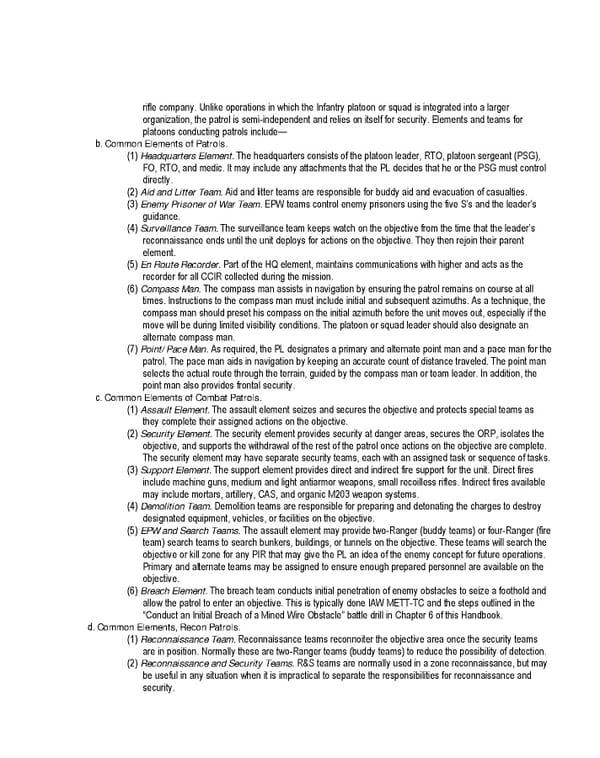rifle company. Unlike operations in which the Infantry platoon or squad is integrated into a larger organization, the patrol is semi-independent and relies on itself for security. Elements and teams for platoons conducting patrols include— b. Common Elements of Patrols. (1) Headquarters Element. The headquarters consists of the platoon leader, RTO, platoon sergeant (PSG), FO, RTO, and medic. It may include any attachments that the PL decides that he or the PSG must control directly. (2) Aid and Litter Team. Aid and litter teams are responsible for buddy aid and evacuation of casualties. (3) Enemy Prisoner of War Team. EPW teams control enemy prisoners using the five S’s and the leader’s guidance. (4) Surveillance Team. The surveillance team keeps watch on the objective from the time that the leader’s reconnaissance ends until the unit deploys for actions on the objective. They then rejoin their parent element. (5) En Route Recorder. Part of the HQ element, maintains communications with higher and acts as the recorder for all CCIR collected during the mission. (6) Compass Man. The compass man assists in navigation by ensuring the patrol remains on course at all times. Instructions to the compass man must include initial and subsequent azimuths. As a technique, the compass man should preset his compass on the initial azimuth before the unit moves out, especially if the move will be during limited visibility conditions. The platoon or squad leader should also designate an alternate compass man. (7) Point/ Pace Man. As required, the PL designates a primary and alternate point man and a pace man for the patrol. The pace man aids in navigation by keeping an accurate count of distance traveled. The point man selects the actual route through the terrain, guided by the compass man or team leader. In addition, the point man also provides frontal security. c. Common Elements of Combat Patrols. (1) Assault Element. The assault element seizes and secures the objective and protects special teams as they complete their assigned actions on the objective. (2) Security Element. The security element provides security at danger areas, secures the ORP, isolates the objective, and supports the withdrawal of the rest of the patrol once actions on the objective are complete. The security element may have separate security teams, each with an assigned task or sequence of tasks. (3) Support Element. The support element provides direct and indirect fire support for the unit. Direct fires include machine guns, medium and light antiarmor weapons, small recoilless rifles. Indirect fires available may include mortars, artillery, CAS, and organic M203 weapon systems. (4) Demolition Team. Demolition teams are responsible for preparing and detonating the charges to destroy designated equipment, vehicles, or facilities on the objective. (5) EPW and Search Teams. The assault element may provide two-Ranger (buddy teams) or four-Ranger (fire team) search teams to search bunkers, buildings, or tunnels on the objective. These teams will search the objective or kill zone for any PIR that may give the PL an idea of the enemy concept for future operations. Primary and alternate teams may be assigned to ensure enough prepared personnel are available on the objective. (6) Breach Element. The breach team conducts initial penetration of enemy obstacles to seize a foothold and allow the patrol to enter an objective. This is typically done IAW METT-TC and the steps outlined in the “Conduct an Initial Breach of a Mined Wire Obstacle” battle drill in Chapter 6 of this Handbook. d. Common Elements, Recon Patrols. (1) Reconnaissance Team. Reconnaissance teams reconnoiter the objective area once the security teams are in position. Normally these are two-Ranger teams (buddy teams) to reduce the possibility of detection. (2) Reconnaissance and Security Teams. R&S teams are normally used in a zone reconnaissance, but may be useful in any situation when it is impractical to separate the responsibilities for reconnaissance and security.
 Ranger Handbook Page 113 Page 115
Ranger Handbook Page 113 Page 115